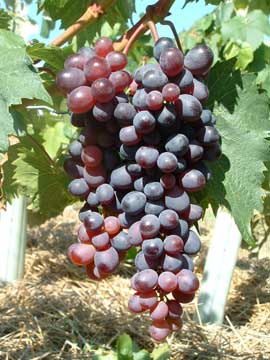Our own grapes are healthy
A nutritious pleasure: the grape
Stacks of books about the health value of wine fill the shelves. If one realises how much more the raw material, the grape, promotes our health, fresh fruit and the juice obtained from it are an indispensable part of the menu. Recently, there have been varieties specially designed for fresh consumption for growing in our own garden, which have larger berries and are resistant to powdery and downy mildew. They taste much better than the very robust "American vines" which used to be common in gardens.
 It's the colour
It's the colour
Red comes before green and blue before yellow, respectively, when it comes to evaluating the ingredients of grapes. Reason: Intensely dark-coloured fruits and vegetables contain larger amounts of health-promoting colourings. The pigments from the polyphenol group of substances are particularly effective in terms of health value. The grape contains mainly flavonoids. These include compounds such as quercetin, catechin, combiferol and, in the case of dark varieties, large quantities of anthocyanins.
These substances reduce the tendency to thrombosis, regulate the cholesterol level, protect the vessels and prevent cancer. They act as highly effective antioxidants that bind harmful free radicals in the body's cells and thus not only protect the cells from tumour formation but also delay the ageing process.
Plant dyes protect and prevent
Since it has been known for some years that red plant dyes protect against tumours and infarcts, biochemists, nutritionists and physicians have been focusing on another connection. It was first found in hellebore species (Veratrum) and was subsequently named Resveratrol. The plant produces this phytoalexin to protect itself from harmful organisms. As these substances are mainly effective against fungi, they are formed mainly in the outermost cell layers - in the case of grapes in the berry skin. A part of this anti-cancer agent is also transferred into the wine. The contents vary between 0.1 and 2.3 mg/litre. The fact that red wines have higher levels of resveratrol than white wines is due to the technology used in winemaking: only red wines have the skins of the berries fermenting for a while, while white wines are freshly pressed and the juice ferments without the skins. At the beginning of 1998 Italian scientists published the result of their resveratrol study: the substance contained in grapes prevents the degenerative brain diseases Alzheimer and Parkinson. Resveratrol activates the brain cell enzyme map kinase, which supports the regeneration of the nerve processes. French researchers came to similar results.
Table 1: Ingredients of 100 g grapes
| kcal/kJ | 68/280 |
| Wasser (%) | 81 |
| Kohlenhydrate (%) | 16 |
| Eiweiß (%) | 0,7 |
| Fett (%) | 0,3 |
| Säure (%) | 1,2 |
| Mineralstoffe (%) | 0,5 |
| Pektin (%) | 0,3 |
Delightful grape cure
Grapes also contain balanced amounts of all important ingredients. The contents of strong B vitamins, especially folic acid, are remarkably high. This B-vitamin plays a central role in blood formation and has a positive influence on our mood. The carbohydrate fructose raises the blood sugar level and counteracts tiredness, nervousness and lack of concentration. Since the body can convert fructose immediately, grapes are valuable energy providers and fitness enhancers. The abundant manganese is important for bones, thyroid gland and nerves. The minerals potassium and magnesium are also found in large quantities.
The fibre in shells and kernels, the swelling agent pectin and the fruit acids stimulate the intestinal activity. Pectin simultaneously binds toxins and cholesterol. Thanks to their detoxifying and draining effect, grapes are suitable as a helpful dietary companion. They provide all necessary valuable substances in connection with a calorie-reduced diet. Local grapes are only available for a limited time. Juice pressed from them, however, can be offered all year round. Compared to the raw material, the grape, it contains similarly high contents of valuable ingredients (see Table 2). The Fitmacher grape juice offers many of the health effects attributed to wine and should be regularly served on the table or in the glass as a tasty alternative to apple juice.
Table 2: Components of grapes and grape juice
| | Trauben
(100 g) | Traubensaft
(100 ml) |
| Vitamin C (mg) | 4 | 1 |
| Vitamin E (mg) | 0,7 | 0,2 |
| Vitamin B1 (mg) | 0,05 | 0,04 |
| Vitamin B2 (mg) | 0,03 | 0,02 |
| Vitamin B5 (mg) | 0,3 | 0,2 |
| Vitamin B6 (mg) | 0,07 | 0,02 |
| Kalium (mg) | 183 | 130 |
| Phosphor (mg) | 2 | 12 |
| Kalzium (mg) | 18 | 15 |
| Magnesium (mg) | 10 | 10 |
| Natrium (mg) | 3 | 2 |
| Eisen (mg) | 0,5 | 0,4 |